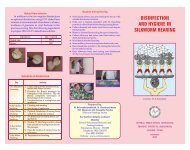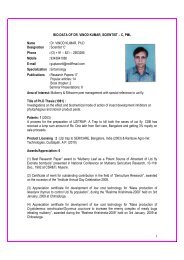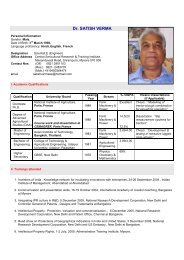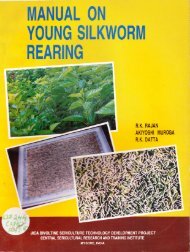Silkworm
A Treatise on the Acid Treatment of Silkworm Eggs - Central ...
A Treatise on the Acid Treatment of Silkworm Eggs - Central ...
You also want an ePaper? Increase the reach of your titles
YUMPU automatically turns print PDFs into web optimized ePapers that Google loves.
Major Physlological Changes in HCI activated eggs<br />
Hydrochloric acid treated eggs are regarded as artificial non-cliapaus.e eggs since they have little<br />
difference as regards morphogenesis in comparison to natural non-diapause eggs. lt is still an open<br />
question and enigma as to how the acid acts in blocking diapause. Sonre of the theories are as under :<br />
1. Miura (1929) first reportedthatactivation andhatchingof eggsbyHClisduetotheelectroncharge<br />
of the chloride ion and concluded that the hatching possibilily or impossibility of the eggs depends<br />
upon the eggs' ability to absorb negative ions.<br />
2. Okada (1971) and Sonobe (1979) reported that soaking of 20 to 24 hours old eggs in HClsolution<br />
enhances oxygen permeability of the chorion which preve.nts the occurrence of diapause.<br />
3. HCI treatment increases the rate ol water loss abruptly, suggesting the prevention of diapause.<br />
(Sonobe,1979).<br />
4. HCI permeated through the egg shells during the course o{ treatment brings about a decline in pH<br />
values ol egg contents (Yoshimi et al 198G).<br />
The main physio-biochemical changes brought about by HCltreatment in diapausing eggs are discussed<br />
in detail.<br />
CHANGES ASSOCIATED WITH PROTEIN METABOLISM<br />
a. Impediment in protein synthesis activity<br />
The protein synthesis activity of the yolk cells is entirely dependent on certain coded information or<br />
an unknown material from the embryo.This material from the embryo may contribute to the protein<br />
synthesizing system from RNA to protein synthesis. These yolk proteins which are newly synthesized<br />
underthe control of this embryonic information may be a particular enzyme necessary for the onset of<br />
diapause and contribute to the conversion of glycogen. This protein stays for a very briel period and is<br />
sufficient for the onset of diapause.<br />
One day old pre-diapause eggs are extremely sensilive to HCl. All the eggs treated with HCI change<br />
to non-diapause ones and manilest good hatchability. On the other hand, three day old eggs are lar less<br />
sensitive to HCltreatment and less than 10% of the eggs can be activated. lt is evident that after 24 hours<br />
of oviposition certain changes in physiological processes concerned with diapause have progressed so<br />
lar that they could not be reversed. As a result, the lreatment turns out to be ineffective.<br />
The protein synthesis activity of the yolk cells is arrested when the eggs are treated with HCI about<br />
24 hours afteroviposition. Acid treatment impedes embryonic role in the protein synthesizing system of<br />
the yolk cells which results in embryonic development like the non-diapausing embryo and the FINA<br />
synthesis of the yolk cells is not inhibited by acid treatment or cold storage or both.<br />
b. Changes ln Isozyme, Esterase-A<br />
The silkworm eggs contain a number ol esterase isozymes of wlrich esterase-A is closely related to<br />
the development of the embryo and is reported to be responsible for lysis of the yolk cells. The addition<br />
of esterase-A to the cultures of yolk cells causes lysis of the yolk ceil membranes. lt is possible that this<br />
enzyme may coordinate in mobilizing the yolk needed by the diapausing embryo lo resume development.<br />
The diapause hormone has been reported to exert an inhibilory effect on this isozyme. By blocking<br />
esterase-A, diapause hormone enforces the diapause by denying the embryo access to yolk.<br />
Non-diapausing eggs of 20 hours age, after oviposition, exhibit a high esterase activity. On the<br />
contrary, diapausing eggs of the same age show very low activity. When acid treatment is performed on<br />
these eggs, the esterase-A activity rises abruptly about 30 minutes after treatment. The activity becpmes<br />
more and more pronounced in one to two hours after treatment aimost matching with that of nondiapausing<br />
eggs of the same age.<br />
The instant response ol diapausing eggs to acid treatment suggests the possibility that the esterase-<br />
A protein itself would be conlained in a masked form and the acid treatment would activate the inert<br />
36




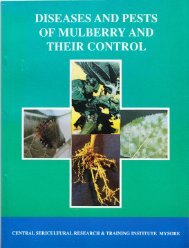

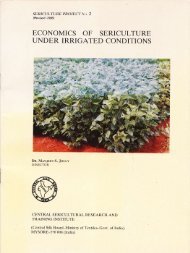
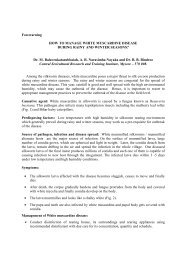
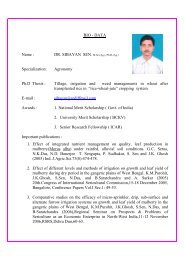
![E}A]\GALORE](https://img.yumpu.com/54052619/1/190x260/eagalore.jpg?quality=85)
